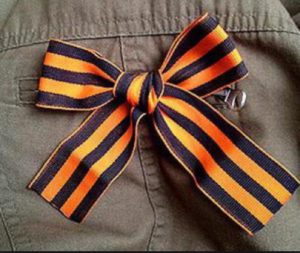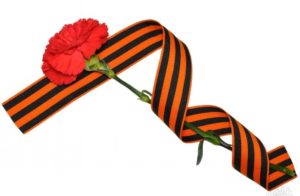In the countries of the former USSR, there is an annual tradition of pinning a black and orange ribbon during the celebration of Victory Day. Ribbons that are distributed in public places allow everyone to feel involved in this important event. But few people know how this “St. George” ribbon appeared. This is exactly what our article will tell you about.
Where did it come from and why is it called that?
The St. George Ribbon appeared under Catherine II along with the Order of St. George, the highest military award of the Russian Empire. The order was established on November 26, 1769 during the Russian-Turkish War to reward officers for their courage and loyalty to the Russian Empire.. Chief Chamberlain Count Litta wrote in 1833: “the immortal legislator who founded this order believed that ribbon connects him color gunpowder and color fire."
What colors are there?
 In 1769, the ribbon had only three black and two orange stripes.
In 1769, the ribbon had only three black and two orange stripes.
In Soviet awards during the Great Patriotic War and after it, there was a moire silk ribbon with longitudinal stripes of equal width - three black, two orange. And along the edges there was a narrow orange border.
In 1992, a Decree of the President of the Russian Federation was issued on the restoration of the St. George Cross as awards, and the ribbon had to return to its original version in terms of the location of the stripes and color combination.
Why is it considered a symbol of Victory?
 After the revolution of 1917 and the overthrow of the monarchy, the entire award system was abolished, including the Order of St. George. But it continued to be used in the White Army and emigrant circles.
After the revolution of 1917 and the overthrow of the monarchy, the entire award system was abolished, including the Order of St. George. But it continued to be used in the White Army and emigrant circles.
The St. George ribbon - now called the Guards Ribbon - returned to our country during the Great Patriotic War, when guards units were established in the Red Army, following the example of those that once existed in the army of the Russian Empire.
Then this ribbon appeared on some Soviet military award and anniversary badges of the war and post-war periods:
- medals “For victory over Germany in the Great Patriotic War of 1941–1945”;
- Order of Glory;
- medals “For the Capture of Berlin”;
- medals “Thirty Years of Victory in the Great Patriotic War”;
- medal “Forty Years of Victory in the Great Patriotic War” and others.
Modern symbolism of the St. George ribbon
 The public campaign to distribute ribbons on Victory Day has been held since 2005 with money from public, commercial organizations and the state budget. In 2008, it was taken up by more than thirty countries. The colors of the ribbons distributed during the event correspond to the colors of the ribbon that covers the block of the medal “For Victory over Germany.”
The public campaign to distribute ribbons on Victory Day has been held since 2005 with money from public, commercial organizations and the state budget. In 2008, it was taken up by more than thirty countries. The colors of the ribbons distributed during the event correspond to the colors of the ribbon that covers the block of the medal “For Victory over Germany.”
This annual flash mob is held in order not to let the younger generation forget the cost of victory in the bloodiest war in the history of mankind. This tribute is neither commercial nor political.
Interesting! The international campaign has both like-minded people and opponents. According to the latter, this event shows disrespect for veterans. The undeserved use of the order's symbol by people who, after the holiday, throw it on the ground, trample it underfoot, tie it to cars, bags, pets, or attach it to shoes, they consider black ingratitude towards the winners. There are probably such people, but most Russians respect the symbol of Victory.



 0
0






The tape has nothing in common with the Great Patriotic War
scarlet or red victory ribbon
St. George's only existed under the Tsar, and the Guards' one was similar but with an orange color.
and in Europe it is a sign of the devil